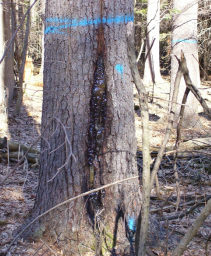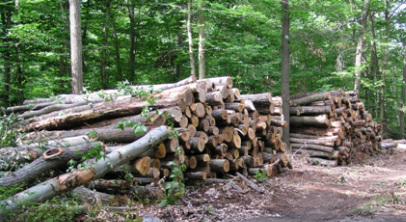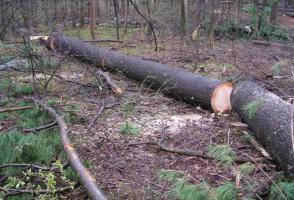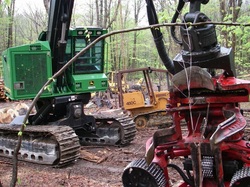TIMBER SALES

Why Cut Trees?
Timber harvests are an important means of achieving forest management goals. Removing defective, diseased, inferior trees makes more resources available to more desirable trees, improving the overall health of the forest while increasing its value over time. Timber harvests can also be used to regenerate the forest, providing conditions suitable for the establishment and growth of the seedlings and saplings that will make up the next generation of forest. In addition to these objectives, timber harvests can improve wildlife habitat and recreational opportunities on the property. When managed properly, a forested property can yield returns for the landowner several times over the course of an ownership. Forest products derived from property can be a significant wealth generator. At minimum, the sale of forest products offsets the cost of ownership, providing a means to the landowner for retaining a property.
Timber harvests are an important means of achieving forest management goals. Removing defective, diseased, inferior trees makes more resources available to more desirable trees, improving the overall health of the forest while increasing its value over time. Timber harvests can also be used to regenerate the forest, providing conditions suitable for the establishment and growth of the seedlings and saplings that will make up the next generation of forest. In addition to these objectives, timber harvests can improve wildlife habitat and recreational opportunities on the property. When managed properly, a forested property can yield returns for the landowner several times over the course of an ownership. Forest products derived from property can be a significant wealth generator. At minimum, the sale of forest products offsets the cost of ownership, providing a means to the landowner for retaining a property.

Types of Forest Products
A typical timber sale can yield a variety of both tree species and forest products. Forest products that may be sold, in order from most to least valuable, are: veneer logs, grade saw logs, low-grade or pallet logs, railroad tie logs, pulpwood, firewood, and whole tree chips. Market demand, time of year, timber quality, and availability of markets are a few factors that dictate the ultimate value of the timber sale. A timber sale down the road on a neighbor’s property might not be comparable to your own, due to differences in landowner objectives, access, terrain, timber type, and past cutting.
A typical timber sale can yield a variety of both tree species and forest products. Forest products that may be sold, in order from most to least valuable, are: veneer logs, grade saw logs, low-grade or pallet logs, railroad tie logs, pulpwood, firewood, and whole tree chips. Market demand, time of year, timber quality, and availability of markets are a few factors that dictate the ultimate value of the timber sale. A timber sale down the road on a neighbor’s property might not be comparable to your own, due to differences in landowner objectives, access, terrain, timber type, and past cutting.

How Does It Work?
Timber sales can be handled in a variety of ways. In some instances it is advantageous to sell the timber on a competitive, lump-sum basis. The timber sale is marked or delineated, and a prospectus is presented to potential buyers, after which they view the timber to be sold, speculate on its value, and submit bids. In other cases, a scaled sale is employed, whereby the purchaser pays for what is actually yielded from the sale. This method often works well with low-grade sales where a large amount of whole tree chips is to be sold.
Timber sales can be handled in a variety of ways. In some instances it is advantageous to sell the timber on a competitive, lump-sum basis. The timber sale is marked or delineated, and a prospectus is presented to potential buyers, after which they view the timber to be sold, speculate on its value, and submit bids. In other cases, a scaled sale is employed, whereby the purchaser pays for what is actually yielded from the sale. This method often works well with low-grade sales where a large amount of whole tree chips is to be sold.

In all cases it is important that all parties involved (seller, forester, purchaser) agree to a contract, so that each party fully understands the requirements and obligations. The contract should include provisions for payment, timing and contract length, acceptable practices related to erosion and sedimentation, insurance requirements, etc.
It is the role of the forester to discuss the objectives of the timber sale with the property owner. It is also the forester’s role to explain what will happen during a timber harvest and describe the immediate result; timber harvesting can be messy and have the appearance of chaos to the untrained eye.
It is the role of the forester to discuss the objectives of the timber sale with the property owner. It is also the forester’s role to explain what will happen during a timber harvest and describe the immediate result; timber harvesting can be messy and have the appearance of chaos to the untrained eye.
Upcoming Timber Sales

Please contact us for the most up-to-date information on upcoming timber harvests.